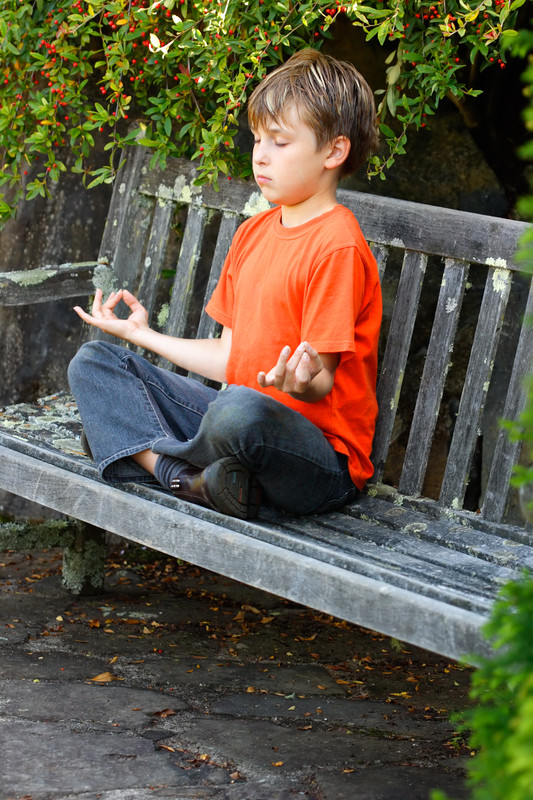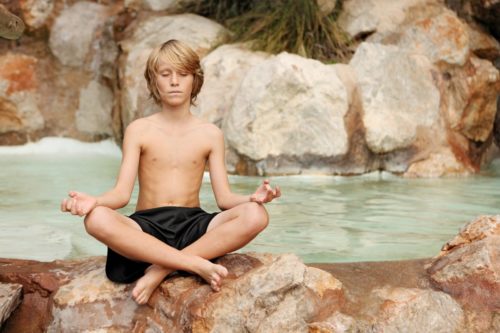Meditation For Kids and Time-Outs
I had a friend post an article on his blog about how to cope with tinnitus. He’s not a medical person but has intimate knowledge of the problem from the standpoint of what actually works, and he discussed how meditation helps him.
I communicated with him a little about it and told him that I’d been working on a post about meditation for this blog for about two years. Actually, it’s been sitting in the “possibles” pen for that long, awaiting a bump into production.
Teen using a yoga pose for meditation
As strange as it seems, I took some friends to the Henry Doorly Zoo one day while living in Omaha Nebraska and met a boy absorbed in a yoga pose on one of the many benches that nobody seemed to be using. The children that I was with were running between the many monkeys in the area which left me to watch them from the central location.
While standing there, I was trying to decide whether or not it would be appropriate to say something to the boy or just stand there waiting for him to get back into the world. I then noticed a woman standing off to one side and caught her eye, who advised me “don’t talk to him please he’s being disciplined.”
Meditative Time-Out’s In Parenting
Mindfulness, Meditation and Tantrums
It wasn’t lost on the pediatrician side of me that she used the word “disciplined” instead of the most common word: “punished”; so, obviously that precipitated a most interesting conversation between us. I won’t expand on it here; but basically, this family had been practicing yoga and meditation long before the boy had been diagnosed with Asperger’s Syndrome and Hyperactivity when he was nine.
Of course, their family’s practices were integrated into the therapy and other treatment he had received over the subsequent two years and one of the things they found which helped was to use “Meditative Time-Outs” in their parenting as an adjunct to his medication and cognitive therapy.
When they observed circumstances beginning to unwind in spite of everything, they used the admonishments progressing to warnings just like all parents do; but, when the lines had been crossed, they told him “Time Out” and pointed to a place he should be.
She tapped him gently on the shoulder to end his 5-minute time-out and asked him how he felt, just about the time one of my friends swung back around to see where I was, and I introduced him to those who were with me. That meant I got to stay for a little while longer and continue the enlightening conversation with his mom.

Of course all this wouldn’t work without prior preparation and training before-hand; but, she told me that meditation had been a Godsend for her and her husband. Simply 5 minutes of what she called “mindfulness” was enough to bring him entirely back to “normal” she said and allowed them to use much less medication and, in some circumstances, go a full day without them.
In fact, as it turned out, they had become quite the local celebrities in the “aspie” groups, and a lot of people found it helpful.
Even he was aware of its benefits to his many situations and accepted time-outs readily and willingly. He used them merely as one of his “tools” for living his life with his condition. He could meditate without embarrassment anywhere, as I had just seen, and be ready to go forward almost without breaking his step.
Meditation – Mindfulness
Meditation, mindfulness, self-hypnosis, yoga and probably a lot of other things are largely all the same—but different.
You do not go into a “trance” or some other time warp. You are still completely grounded on the earth and present in time. Your brain does NOT shut off, you are still completely aware.
Your mind still has all its frailties, like trying to wander or go to sleep; but all of these things are just different methods of helping you control where it goes a little bit better.
You don’t lose control but are learning to be in better control or take control. Those thoughts you become mindful of, when practiced, become disassociated a bit with the emotions and stress they normally carry. THAT’S what people mean when they say they can “think more clearly” when mediating. Thoughts can be thought more objectively, plans can be planned more clearly.
Anyone can learn the techniques, even children… even toddlers. Learning does take a little effort to have some seclusion and less distraction; but, once learned, it can be done anywhere with little effort. Honestly, though, it seems to me that it’s a little more difficult to learn for children with attention problems; but not impossible.
AND it always produces results—less tension, less stress, lower blood pressure, less tantrum, less anger…
How Do You Do It?
I ran across a small series of audio tracks which can basically teach you the techniques for meditation in minutes. Really.
Here are four of them: one, four, ten and 15 minutes long.
Shut the door, sit back, click play, close your eyes and make your troubled mind obey for just 60 seconds. Follow the ques and see if you don’t know that I’m right.
One Minute Meditation
Four Minute Meditation
Ten Minute Meditation
15-Minute Meditation
Directed Relaxation and Stress Reduction

Because this is an ill-defined endeavor, and in some cases quite lucrative, there are about as many techniques for relaxation as there are causes of stress—and people to take advantage of them.
My basic rules of thumb are: if the person telling me about them stands to have no financial gain – then, it’s probably honest and may work; and, if you try it and it works for you – then it’s possibly grounded mostly in some correct principle; and, if it stands alone requiring no extra paraphernalia or altered environment or capital outlay – then it’s mostly likely going to be useful… to me.
Here’s the truth: any untoward issue you have belongs to an underlying problem which needs to be ameliorated or solved in order to be resolved and that will never be accomplished by tangential gimmicks; BUT, the physical side-effects of unsuccessfully trying to either solve or live with the untoward issue is called stress, which often can be lessened by the “gimmicks” of meditation, yoga and the like, even though they are tangential to the core issue.
Huh?! Basically: mediation, yoga and the like don’t solve the core problem but possibly can give significant and substantial benefit to all the related stress caused by it.
So, back to the next level of techniques which you may find useful and which I’ll include here for completeness’s sake.
Body Scan Meditation
Walking Meditation
Mindful Eating
Limitations and Disclaimers
The thing is, all of the above are free and (except for the NY Times commercial which I couldn’t take out) completely noncommercial. Everything about the core, beneficial meditative practices I’ve outlined here – and the ONLY kind with ANY actual scientific proof – is available to all, free and without any added complications or burdens in your life.
If you feel like you want to read a book to gain a bit more insite—there are P L E N T Y available at the library for free.
They, meaning the techniques, CAN reduce the stress symptoms (as I’ve defined above) but ONLY that. Contrary to what nearly every “guru” I’ve met wants to tell you it DOES NOT give “calmness” or “happiness” or any other such “marketing” overstatements and claims used largely for monetary reasons. All those are solely up to you and the result of your own work not the result of some secret technique or mantra.
Meditation (or whatever word you use) is a proven stress reduction technique, a self-care practice, which, just like any habit, is easier to do if it’s part of your routine, tailored to your specific circumstances and you have a good attitude about it because you notice the benefits exceed the effort.
I told you that the boy I met at the Zoo was using a yoga pose, another aspect of the meditation I’ve been talking about; but I’ll make that another post because I need to show some photos which will make them more understandable.
2 Posts in Meditation (meditaion) Series
- Tantrum-busting and Yoga poses – 20 May 2017
- Audios, Meditative Time-Outs – 12 May 2017
Advertisement by Google
(sorry, only few pages have ads)

